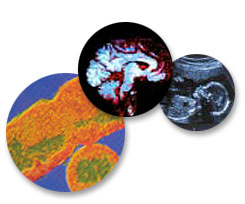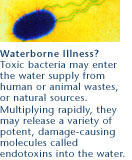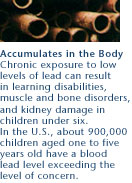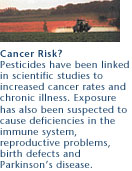For USA and International Enquiries 1(775) 324-2400 24/7
Espanol (Rudy Altamirano) 1(760) 207-6801

Common Issues with Poor Quality Water
Usually you cannot see, smell, or taste contaminants, but if they are in your water, the potential danger to your health is staggering. Learn more about:
Bacteria
Lead
Pesticides
Nitrates and Nitrites
Chlorine
Hardness
pH
Bacteria

THE MOST LIKELY SOURCE OF ACUTE WATER-BORNE DISEASE - E. coli Bacteria and other potentially dangerous microbes are commonly found in our environment, but they should not be present in our drinking water. Thousands of cases of bacterial illness occur every year, many of them fatal.
Many strains of bacteria are not toxic, but some can cause very serious illness. Even mild cases can result in diarrhea, vomiting, cramps, and other gastrointestinal symptoms. Young children and those with weaker immunity are more likely to be affected. Since contaminated water may not taste or smell "bad", most cases of water-borne disease are not likely to be identified as such. The presence of bacteria in drinking water indicates that treatment methods are not working properly and are not adequate to remove all viable microbes. When treatment fails, drinking water may become potentially toxic. Community water systems take steps to disinfect drinking water, but they may not become aware of problems until it's too late. This bacteria was first recognized as a cause of illness in 1982.
Lead

LEAD FROM PIPES CAN LEACH INTO HOUSEHOLD WATER USED FOR DRINKING, COOKING, AND WASHING - Many homes and buildings have pipes and plumbing fixtures that contain lead. Lead can leach from pipes into household water, making this plumbing a major source of water contamination and a potential source of toxic lead poisoning.
Lead is so toxic that even very low levels may be dangerous. Lead consumption and poisoning has been linked to many serious illnesses, especially in young children. Lead can harm mental and physical development and may cause brain abnormalities, kidney damage and hypertension.
As with other water contaminants, the risk of lead damage are much greater for children than for adults --families should be particularly concerned about the health of the water supply. Consumers should test lead levels at each faucet in the home, especially if the plumbing fixtures could be from the 1980's or older. Lead from pipes can leach into household water used for drinking, cooking and washing.
Pesticides

PESTICIDES ARE COMMONLY FOUND IN DRINKING WATER - Pesticides are deadly chemicals used to eliminate weeds, insects and other harmful elements in crops. Their pervasive use, however, has produced its own harm. Now it is not uncommon to find pesticide contamination in our drinking water.
Atrazine and Simazine are two of the pesticides most commonly found to contaminate drinking water. More than 60 million pounds of these two chemicals are introduced into the environment each year as herbicides, and left to potentially leak into the soil, groundwater, and the lakes and rivers that are the sources for the water we drink. They are so toxic that the EPA-mandated maximum level is equivalent to less than one drop in a swimming pool.
There are laws that require the regular testing of community water supplies, but they are, in practice, rarely tested.
Nitrates and Nitrites

A COMMON YET INCREDIBLY HARMFULL POLLUTANT ESPECIALLY TO CHILDREN AND SMALL ANIMALS - When animal and human wastes or field fertilizers come into contact with water, they show up as nitrates and nitrites. Both are serious contaminants because they affect the very core of human life - birth and the development of young life. In 1992, when the survey was released, some 22,500 infants drinking domestic well water were estimated to be exposed to levels of nitrates exceeding the EPA safe drinking water limits; for community systems, the number was estimated to be 43,500 infants.
Chlorine
DRINKING CHLORINE IN SMALL AMOUNTS MAY NOT HURT YOU, BUT CHLORINE BY-PRODUCTS CAN - The consumption of chlorine in very small amounts most likely will not cause you serious harm. What may be harmful, however, are the by-products, including chloroform, that chlorine produces when mixed with organic matter.
Hardness
WHEN YOU HAVE HARD WATER, IT CAN TAKE TWICE AS MUCH SOAP TO DO YOUR LAUNDRY - Water hardness is primarily caused by calcium and magnesium compounds. These chemicals are not easily detected, but the numerous negative effects can be unpleasant and costly. When you have hard water it can take twice as much soap to do your laundry.
pH
KNOWING THE PH LEVEL OF YOUR WATER CAN HELP YOU PREVENT SECONDARY EFFECTS - If the acidity of your water is too high, corrosion can leach out lead from pipes and plumbing as well as damage your water supply system and water heater.


